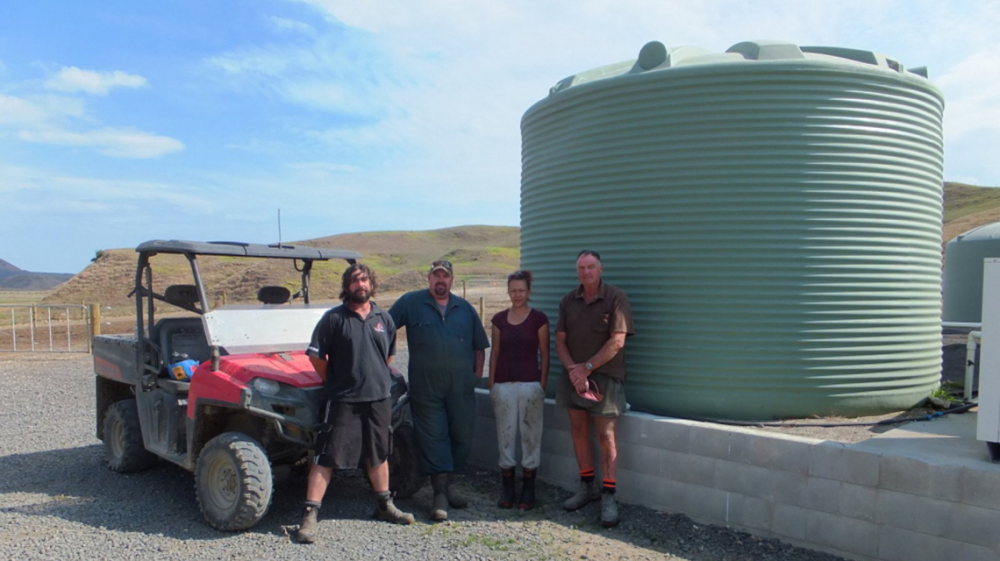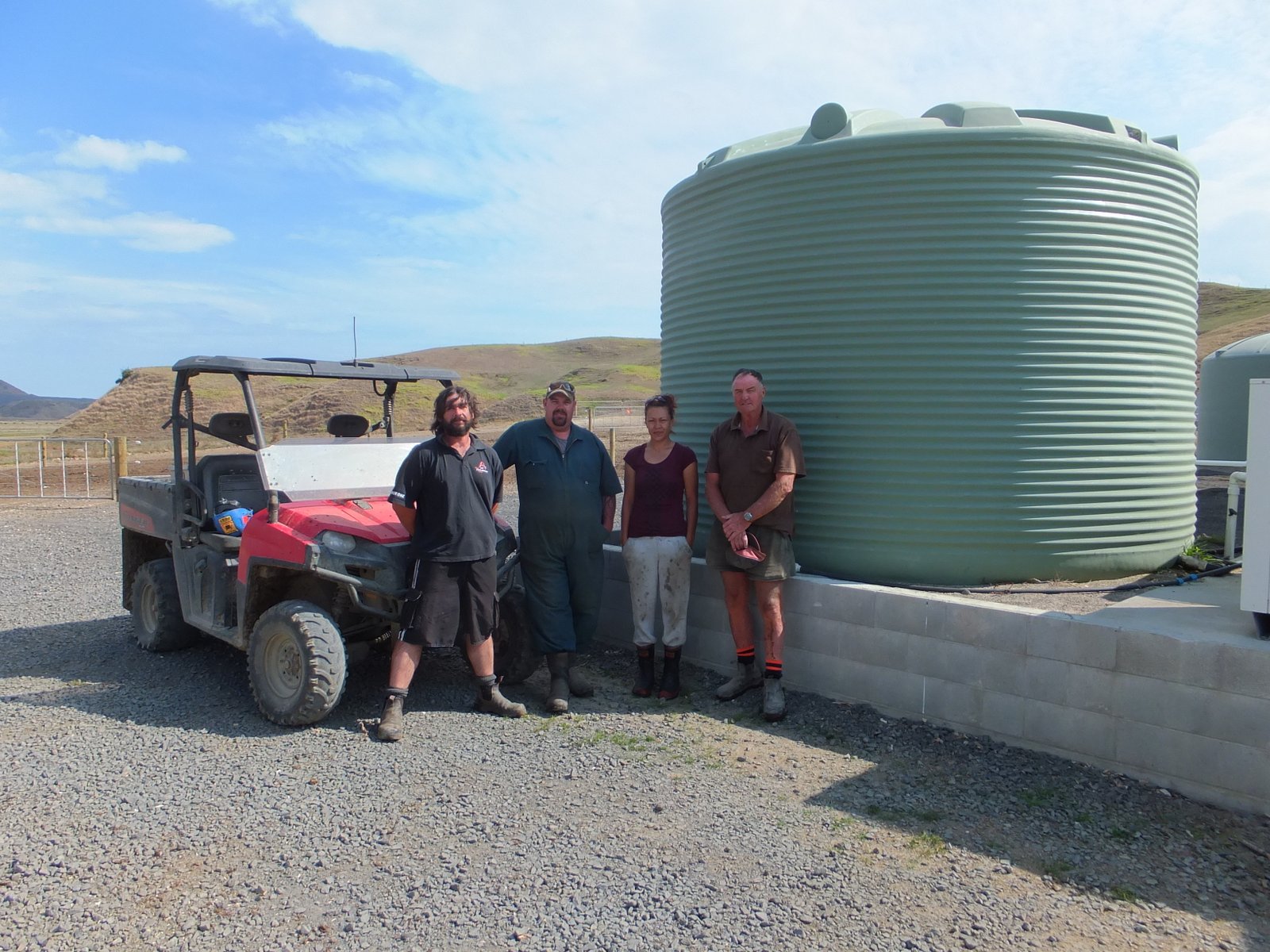Wednesday, 21 January 2015 Case Studies
A very Cool Dairy Farm Meets NEW regulations with a PROMAX insulated Tank
Ag Journalist Ken Strugnell visits Limestone Downs Dairy Farm to uncover a ‘Chilling’ story!
Over the years I’ve flown home from Auckland to Christchurch and shortly after take off looked down at the mouth of the Waikato river thinking that south of here is where the ‘easy country’ finishes and the hills begin. So it was with some surprise after talking to Limestone Downs Farm Operations Manager Alf Harwood that I found myself heading out to Port Waikato to then travel 20 kms south into the steep hill country I’ve seen so often from 20,000 feet, to look at their brand new dairy conversion.
A warm welcome from Alf and his PA Sue Lourie awaited, as I arrived ½ an hour early. I driven the VW Tiguan over the twisting road that clung to the hillsides and dropped down into little valleys carved over centuries by innocuous looking streams. In fact the last of these, as I was to find out later was the boundary of the 3200 ha station. Yet it was another 15 minutes drive to find the homestead set high on a north facing hillside just a kilometre from the coast.
Limestone Downs was established by Englishman Charles Baker in the 1920’s.
Neither he nor his daughter who inherited the property upon his death in 1942 ever lived on the station, running it, through a series of mangers. In 1960 upon her death the station became a trust, the C Alma Baker Trust, with the express purpose of the “Furtherance of Agriculture and Horticulture in New Zealand”
Now with a resident staff of 10 including Alf and the four that are employed to run the latest venture the 350 ha 800 cow dairy unit, the Trust has embraced the opportunity dairying provides for the bottom line on the books. Alf explains that to ‘future proof’ the farm’s income it was necessary to convert the only real flats to their best use which now is dairying. I was still a little concerned at what these “flats” might be like and so after lunch I headed further south down the metal road vaguely wondering how a dairy farm could exist here on the ridge top overlooking the Tasman.
As I crested the hill I looked west and down to the flats, that Alf had pointed out on the map and sure enough in the distance on the valley floor was a brand new 60 bale rotary shed, with all the ancillary buildings tracks and fences that make up a modern dairy unit. As my photo shows the shed sits in the middle of the 380ha [350 effective] block... I chose a steep somewhat slippery farm track with the hill descent control engaged pointed the Tiguan at it. After the five minute drive down hill, I turned into the yard where the Dairy Manager Aaron Fraser greeted me.
“Enjoy the view?” he said grinning widely. I had done and the closer I got to the shed the easier it was to understand how the dairy unit fitted into this otherwise steep hill station. The dairy farm runs from the coast inland with a couple of paddocks over the road. It is bisected by a stream that has been used to drain the flats.
Aaron explained that the way the station was set up the cows and heifers never needed to leave with the dairy grazing being integrated into the station’s annual planning as was much of the supplementary feed fed out through the winter. The flats looked remarkably green after the drought the northern North Island was suffering. “The water table is quite high here and so as you can see we’ve humped and hollowed the flats to both drain them and also as on the South Island West Coast, to provide dry footing should the table rise”.
I was on the farm to find out about the decision to fit a thermally insulated tank to chill the milk after milking and before it went into the Vat.
With the new regulations applying to new conversions from August 1st 2014 requiring the milk to be at 6 degrees or lower within 90 mins of milking the Trust had sought out the most cost effective long term solution to incorporate when the shed was set up for the 2013 season. After much investigation the neatest and ultimately best option was to use the distinctive corrugated plastic PROMAX polyethylene insulated 30,000 litre tank to chill the milk prior to it going into the vat. I asked Aaron why they didn’t just use the vats own chiller and his answer was direct and to the point. “Won’t work!” he said. “Because it comes out of the plate cooler at around 18 degrees and then would take too long for the vat to chill down a further 12 degrees.
“So the system I have here is very simple. The milk from the cow goes to a double bank plate cooler, the first bank uses bore water at around 16 degrees which chill the milk to that 18 degree mark we talked about earlier then on the other bank of the cooler the 4-5 degree water chilled overnight after milking in the 30,000 litre insulated PROMAX tank drops it down to 5-6 degrees. It is a closed loop system with the water drawn out of the bottom of the tank and pumped through the second bank of the chiller cooling the milk and then being returned to the top of the insulated tank”.
I climb the ladder to the top of the insulated PROMAX tank and put my hand into the water at the top after milking. The coldness is a shock. So much cooler than out of the tap and more like the chilled water from the fridge at home yet there is 30,000 litres of it.
“If ever we ran out of bore water we could use this tank to do ALL the milk cooling and it would still go in the vat at about 7 degrees”. smiles Aaron. So we are future proofed and protected with the only power requirement for the milk being a ½ hp pump from and back to the insulated tank. I’m not needing the vat to chill the milk which is great as it fits in well with the dairy Tanker, so it’s win win all round!
I asked him if it saved money on the power bill to which Aaron said he had no idea as the unit started off with it but his power bill was lower for this shed, than the previous farm he managed. I quoted another farm I’d been on the day before near Rotorua that had retro-fitted the PROMAX system and month on month saw a saving in the shed of between $200-$300 month. “I’d believe that he said.
We were joined by his team [seen in the photo above]: Hayley Purdon, Gordon Honeybun and Matthew Tyson. In chatting to them about the set up they agreed that it made sense and was very easy to operate and explain. “Just one other pump to turn on at milking and then it’s all automatic! Aaron was very complimentary about the staff saying how well they’d fitted in and worked, words I’d already heard from Alf.
Prompting Aaron I asked for his view on the new system of milk chilling. “Well if it’s what’s needed to meet the regulations and helps the industry by being more efficient and uses less time and power it’s a winner as far as I see”
Thanking him I drove back up the hill to the homestead where Alf and Sue were working in the office. Sue gets me a very welcome tea and an even more welcome ham toastie. Thanking her I asked Alf about how he saw the future of Limestone Downs. “Let’s go for a drive” he said. So we drove out to the Airstrip almost the highest point on the farm where there are TWO runways at apposing angles and two bins to allow for different wind directions.
Alf looks out to sea and around the extensive views from the strip and says matter of factly “the dairy unit fitted in with the plan for the farms future well. Keeping all the stock on the place saves time cost and stress on the herd. The use of the latest innovations including the PROMAX milk chilling system meant they we’re well placed to further improve the overall use of the farm”.



